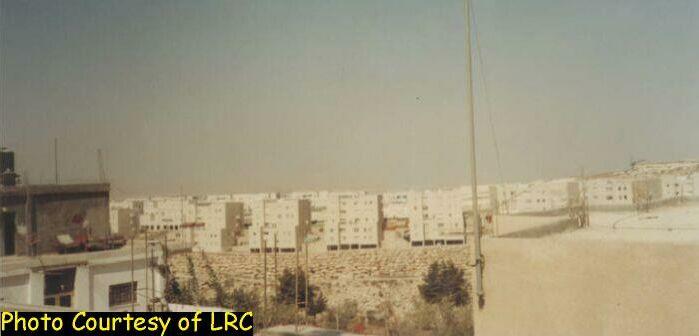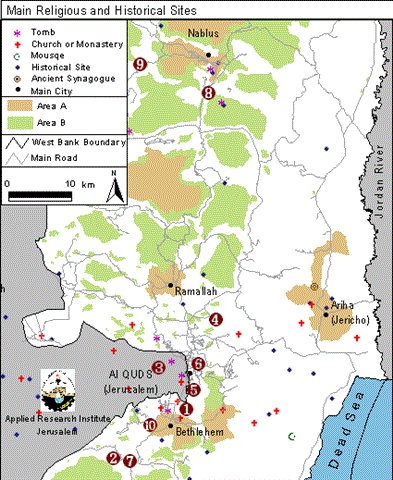The demolishing of Palestinian houses is considered one of the main pillars of Israeli policies in occupied Palestinian cities and villages. Such policy is being used especially in Jerusalem as a tool to Judaize the city and to erase its original Arab life style.
To achieve the aforementioned goals, occupation forces demolished three house in Shu'afat refugee camp on the 29th of August 2000 using a large number of military personnel to accomplish its mission. Details of the demolishing indicates that at 6:00 AM on the above mentioned date two Israeli helicopters circled over the Shu'afat camp to coordinate the advancement of Israeli forces entering the camp from its northern, eastern, and southern entrances. Meanwhile, Israeli tanks closed the main entrances to the camp blocking in the process the traffic flow from or to the camp while allowing tens of military vehicles to invade the camp. Six soldier-packed military busses arrived at the scene from which tens of soldiers stormed the streets of the camp supported by members of the Special Forces riding on motorbikes and horses. An eyewitness indicated that ''more than a thousand'' military personals ''reoccupied the camp once again'' as he described how the occupation forces stationed itself around the soon-to-demolished houses and prevented the residents of the camp from reaching the northern and eastern sides of the camp.
One D9-bulldozer and three diggers rolled across the streets of the camp coming from the settlement of Pisgat Ze'ev. This machinery started the demolishing process at 9:00 AM without showing an official demolishing order and without the presence of the owners of the three houses due to the fact that they were not informed about the whole operation.
Goals Behind Demolishing:
This event is seen as a prelude to the expansion of the southern parts of Pisgat Ze'ev settlement which have enlarged on the expenses of the camp ever since the signing of the Declaration of Principles in 1993. This expansion made the settlement as close as Sufh Al Wad and Al Ahrash that surrounds the camp from the east and north-of-east. Also, the Pisgat Ze'ev settlers have been waging a lobbying campaign aimed at pressuring Ehud Olmert to stop Palestinian build-up which is necessitated by the natural growth of camp's population.
Picture illustrates the encirclement of Shu'afat Camp by Pisgat Ze'ev
That is not to say that Olmert's actions are motivated solely by pressure from settlers. It was reported that his first public announcement after being elected for mayor ship was that he needed to find '' a solution'' for the problems caused by the camp, which reflects a personal and official stance against the camp and its inhabitants. The official stance stems from the fact that the camp is considered to be the last puncture that needs to be filled to complete the total encirclement and isolation of Jerusalem.
Pages of the Dark History of House Demolishing in Jerusalem:
The month of August 2000 witnessed other demolishing in Jerusalem. The Municipality of Jerusalem demolished on the 14th of this month three Palestinian houses in Silwan in addition to three other houses in Shu'afat. A similar campaign in these two areas was carried out in August 1997 when the Municipality demolished seven houses in Shu'afat and three houses in Silwan. The following table lists the houses demolished by occupation forces in August 2000. Please note that demolishing listed below are complete demolishing (not partial)
|
Name |
Demolishing Date |
Location |
Area |
No. of Rooms |
Family Members |
No. of Kids |
|
Jamal Idkeedek |
14/8/200 |
Silwan |
120 |
6 |
5 |
3 |
|
Mohammad Al Taweel |
14/8/2000 |
Silwan |
280 |
14 |
11 |
2 |
|
Naeem Al Taweel |
14/8/2000 |
Silwan |
150 |
4 |
6 |
4 |
|
Mohammad Abu Ghali |
29/8/2000 |
Ras Khamess – Shu'afat |
170 |
9 |
9 |
7 |
|
Ahmad Hosheyah |
29/8/2000 |
Ras Khamess – Shu'afat |
92 |
|
14 |
7 |
|
Ibraheem Alqam |
29/8/2000 |
Ras Khamess – Shu'afat |
180 |
|
12 |
8 |
It is worth mentioning that between the January 1st and August 2000, 15 houses were demolished in occupied Jerusalem. In addition, 21 tents in Essawiyah and a sheep shelter in Al Sawahrah Al Gharbiyah were also demolished. Such events gives a clear signal to the international community regarding the racist foundations of the Israeli occupation and the policy of ethnic cleansing carried out by Israeli policy-makers. Such practices do not contribute positively to the cause of peace in the region.
|
Al Tawil Family's demolished house. |
The ruins of Dekaidek's house. |
Ruins of Ahmad Hoshien's house. |
Prepared by
The Land Research Center
LRC


















